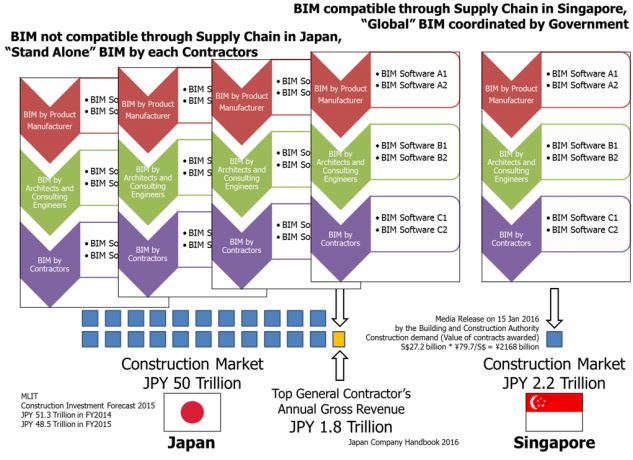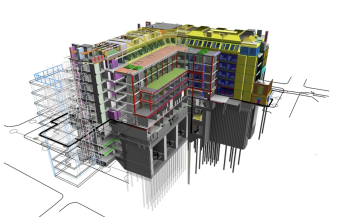Zigurat Global Institute of Technology
Blog / BIM & Construction Management
The current state of BIM implementation in Asia
Categories

BIM has become a transforming force in the construction industry that must be reckoned with. For today’s article, the lecturers of Master’s in Global BIM Management program, Jorge Beneitez Gardeazabal and Eugenio Fontán Yanes bring us the recent developments and progress made in Asia.
For an even more global overview of the implementation developments around the world, Zigurat Global Institute of Technology launches an online event that gathers experts and visionaries in charge of local initiatives and benchmark organizations that shape the BIM practice of their region. Agora BIM World will take place on June 30th at 9:00 AM (CEST) and you can register for it for free here. But to give a little teaser of our BIM world tour now, Jorge Beneitez Gardeazabal and Eugenio Fontán Yanes will give us the current state of BIM implementation in Asia.
Hong Kong is moving forward
On December 1st, 2017, the Development Bureau of the Government of Hong Kong published the Technical Circular (Works) No. 7/2017 about the “Adoption of Building Information Modelling for Capital Works Projects in Hong Kong”. This circular was meant to take effect January 1st, 2018. The Development Bureau states that the Capital Works Projects with budget estimates of more than HK$30 million shall use BIM technology. In simpler words, it means that any company that aims to design and develop any medium to large architecture project will have to do it using BIM. Following the steps of other countries in the region, such as Singapore where the use BIM has been mandatory since 2012, Hong Kong is finally moving forward.
Singapore: A lucky exception
The case of Singapore is quite rare. The City-State, known for being one of the most innovative hubs in the world, saw the potential of BIM technologies in their quest of digitalization. With a top-down approach, in 2010 the Building and Construction Authority (BCA), started implementing the BIM Roadmap with the aim that 80 percent of the industry will use BIM by 2015 aligning with the Government plan to improve the industry productivity by 25 percent over the decade.
 BIM in construction industry of Japan and Singapore.
BIM in construction industry of Japan and Singapore.As part of this plan, BCA collaborated with the GPEs (Government Procurement Entities) to request the use of BIM for all their projects from 2012. Also in the same year, BCA published The Singapore BIM Guide and BIM Particular Conditions to help the industry demystify BIM and to give clarity on the requirements of BIM usage at different stages of a project.
Also in 2012, the Singapore Government launched the BIM Fund aiming to help design firms to build up their BIM collaboration capacity by subsidising up to 50 percent of the cost incurred in Training, Software or Hardware. These, and other policies and financial support, have led to today’s deep implementation of BIM in the industry. Nowadays, it is obliged for architects and consulting engineers to use BIM for design stage, being mandatory for the BIM e-Submission in the government web portal for approvals. The government, who initially accepted native-file-submission, now has moved to a more sophisticated IFC submission, and is training government technicians into the use of Solibry and other tools to check regulations and give approvals. Although this process is obviously not perfect every time, and many companies still go through the hassle of creating a post-BIM from the 2D documents relying on the support of BIM service providers to meet these government expectations, the whole country is moving rapidly into fully digitalising its industry in what is called the IDD (Integrated Digital Delivery) process. Quoting the BCA website: “Integrated Digital Delivery (IDD) is the use of digital technologies to integrate work processes and connect stakeholders working on the same project throughout the construction and building life-cycle. This includes design, fabrication and assembly on-site, as well as the operations and maintenance of buildings. IDD is one of the key thrusts in the Construction Industry Transformation Map (ITM), and is aligned to Singapore's efforts to transform the construction industry by creating a highly-skilled workforce trained in use of the latest architecture, engineering, construction and operations technologies.” This positive and strong top-down approach is leading all the stakeholders in the industry to look into innovation and digitalisation to stay current. The government has a plan to move all these digital assets to a digital-twin platform where they can manage the city at multiple levels, integrating security, sustainability, sensors, robots, driverless transportation systems and other smart city wonders.
Other perspectives from the Southeast Asia region
This is absolutely not the case for most of the countries in the Southeast Asia region where the implementation is irregular and mainly driven by the General Contractors whom, a few years ago, were able to understand the gain that BIM could bring to their business operations. Various governments are trying to catch up with the private initiatives, and encouraged by the examples and efforts made by the UK, Singapore and the US, they have been putting in place roadmaps and plans that are slowly starting to root in the industry. Nowadays, most public tenders are requiring “some” sort of BIM capability, although the standards and expectation vary from case to case. However, the lack of understanding of the technology and its implication in all aspects of a project (including contracts, scopes, legal implications, etc.), has slowed governmental entities in their establishment of clear standards and strong regulations that would have helped the private sector to move along and force the industry to innovate. From the perspective of most consulting firms -including architects, structural engineers, interior designers, MEP engineers, landscape architects, etc., BIM is still perceived as a threat to their business as it disrupts their methodologies and profits. For the majority of them, BIM can have large financial implications -forcing large investments on training and expensive software and hardware. Moreover, because the learning curve of the software can be steep, most of these firms cannot justify the ROI as some of the first projects usually fail to meet their expectations working with a short-term vision for their companies. Also, the virtue of BIM of “revealing everything” is perceived as an inconvenience for consultants, for they would need to do more time-consuming work to coordinate with other stakeholders and impeding the usual little “cheats”, typical of the trade: they show, draw and hence coordinate only what has been agreed as a deliverable with the client. New and young companies who have already entered the game with the knowledge have started to take the lead, showing the industry what is possible with small or bespoke projects. These design companies, like ours, have become a hybrid between boutique design firms and specialised BIM/Digital Consultants, helping larger firms and contractors with their BIM implementation or ad-hoc solutions for those who committed to BIM deliverables without having the capacity. Unfortunately, during the past years there have been too many failed BIM experiments in large projects in the region, due to the lack of planning, commitment and regulations. These have pushed back the excitement of the implementation of these technologies and its benefits. Furthermore, one of the characteristics of this market is the extreme-fast-pace of the projects. This is an obstacle because, as was mentioned before, when using a new technology and paradigm, the first projects will always require a bit more time and effort from everyone to succeed. BIM is still, for now, a challenge for most of the projects and consultants in the region. While trying to build in-house capabilities, bring in foreign talent and ask for more training and implementation, to avoid the use of external BIM consultants. But on the other hand, our impression is that these developments have accelerated in the last 12 months, where both the public and private sectors are becoming more knowledgeable about BIM, transforming the question of “Why BIM?” to “When and How?”.
 Hong Kong Building
Hong Kong BuildingRecently, Hong Kong has announced a fund to support the implementation of BIM technologies for professionals of the AEC industry. This is a very important step that, as seen in Singapore, will help all these companies and professionals to face the cost of innovation. But without a revision in the contractual models of the projects, scopes, deliverables and obligations, this endeavour will still remain long and difficult. Most of the projects’ contracts still require 2D deliverables making the BIM process redundant from the perspective of companies used to the traditional delivery methods. The CIC (Construction Industry Council) is leading the governmental initiatives by arranging trainings, CPD conferences and publishing the Hong Kong BIM standards:
- Download here BIM Standards by the CIC HK
- Building Information Modelling and Geographic Information System by Housing Authority
Small companies are more likely to integrate this process faster because they are more flexible when adapting to changes, such as the adoption of new technologies and changes in their working structures and methods. Big companies with larger teams have to make a bigger effort to change the way teams work together and the tools they use. The Hong Kong fund will support companies in this sense to invest in new software but also in training their team members to make the change to a new working set-up.
What is happening in China, the great unknown?
In China, the biggest player in the region, while government guidelines push for widespread BIM adoption, many AEC professionals are only beginning to see a real need for, or benefit in, adopting BIM at this stage of development. The government is exerting an increasingly strong influence over the AEC industry, driving developments through the introduction of new regulations, standards and requirements. The industry is being forced to change or adapt existing workflows, particularly for government-funded projects. From the shorter-term perspective, the costs of producing BIM models are currently not matched by the limited benefits obtained by its use. Guidelines are thus seen as interfering with market-driven processes that emphasise speed and cost efficiency over integration and quality. The large presence of BIM models in the market is not an indicative of the actual BIM adoption as part of current design workflows -most companies produce BIM models only as add-ons to existing processes. Forced to produce BIM models based on government expectations as well as client demand, larger firms and LDIs are increasingly tasking their BIM departments to develop BIM-based approaches to typical design tasks in order to make use of the time and energy invested into BIM technology. Similar to overseas studies, survey results indicate that new contract models are needed to truly establish BIM models as exchange platforms between different professions – even within the same firm. This lack remains a core challenge for Chinese companies aiming to adopt BIM, and will be addressed gradually with the introduction of new regulations as part of the thirteenth five-year-plan ending in 2020. “Believe it or not, this is the best for the Industry, Architecture and our planet. “ The use of BIM requires more precision, control and reliable processes for designing and executing projects. The AEC industry is known to be at the beginning of the digitalisation curve, only above agriculture, and to be the most damaging to the environment regarding CO2 production and waste generation. The volume of construction waste generated worldwide every year, according to a report from Transparency Market Research, will nearly double to 2.2. billion tons by the year 2025, according to Construction & Demolition Recycling. The Asia Pacific region is expected to generate a majority of the construction waste in the year to come, followed by North America.
Some personal thoughts and conclusions:
Good design is not only a matter of aesthetic sensibility. Good design, in our opinion, must also be able to raise important conversations and tackle important human issues. After all, Design and Architecture must be at the service of humanity. We encourage our peers, contractors and consultants to embrace the improvements that technology is offering to our industry. These are enabling us, designers to give better answers, more sensible to the environment, more executable, more innovative within the boundaries of schedules, budgets and expectations. In addition, we are encouraging our clients, developers and the stakeholders building our cities, to use a better process to build better and more efficiently. All these major leaps need a little bit of extra energy from all of us, to absorb and learn new technologies. Humans have been doing it through all our history; this is another small step towards a better society. Authors: Jorge Beneitez Gardeazabal and Eugenio Fontán Yanes Co-Founders at enzyme APD. Lecturers at Zigurat Global Institute of Technology (Global BIM Management)




